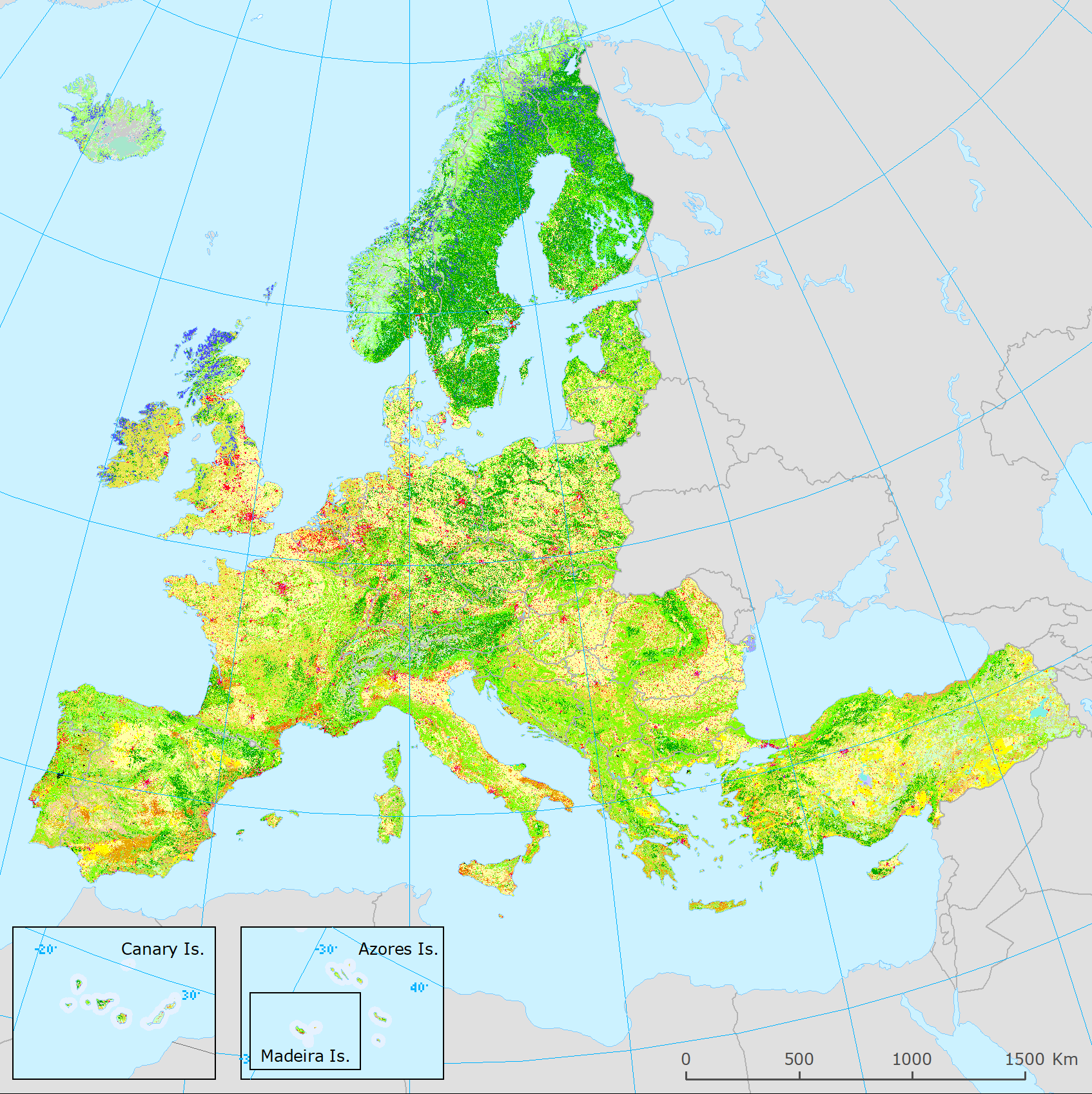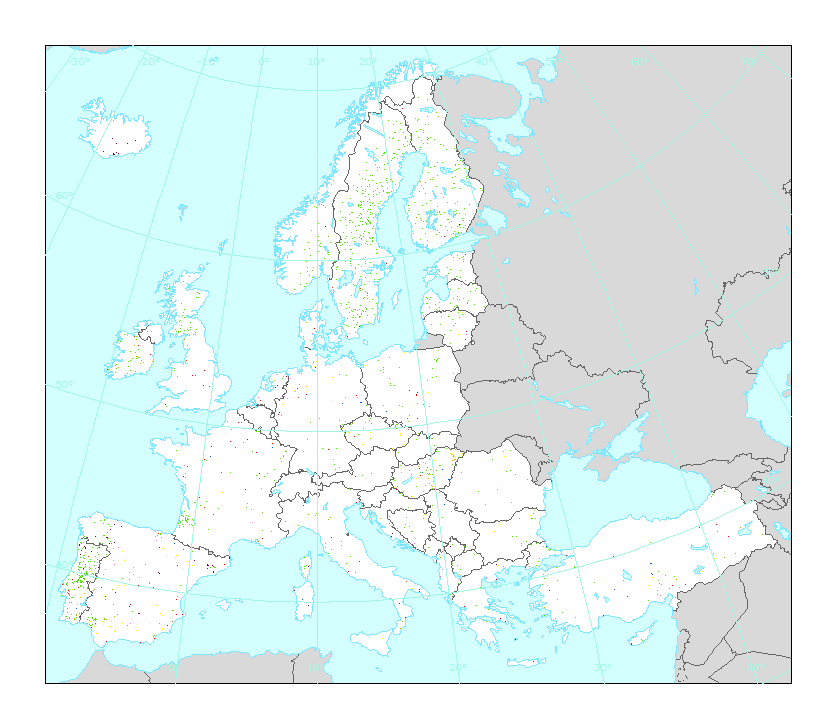accounting
Type of resources
Available actions
Topics
INSPIRE themes
Keywords
Contact for the resource
Provided by
Years
Formats
Representation types
Update frequencies
status
Scale
Resolution
-

The present 100m raster dataset is the 2018 CLC status layer modified for the purpose of consistent statistical analysis in the land cover change accounting system at EEA. CORINE Land Cover (CLC) data are produced from 1986 for European (EEA member or cooperating) countries. Altogether five mapping inventories were implemented in this period, producing five status layers (CLC1990, CLC2000, CLC2006, CLC2012, CLC2018) and four CLC-Change (CLCC) layers for the corresponding periods (1990-2000, 2000-2006, 2006-2012, 2012-2018). Pan-European CLC and CLCC data are available as vector and raster products. Due to the technical characteristics of CLC and CLCC data, the evolution in CLC update methodology and in quality of input data, time-series statistics derived directly from historical CLC data includes several inconsistencies. In order to create a statistically solid basis for CLC-based time series analysis, a harmonization methodology was elaborated.
-

The raster dataset describes land cover flows between 2012-2018. Land Cover Flows summarize and interpret the 44x43=1892 possible one-to-one changes between the 44 CORINE land cover classes. The changes are grouped to so called flows of land cover and are classified according to major land use processes. The nomenclature of flows is organized on 3 hierarchical levels. See lineage on the nomenclature. The classification of land cover flows results from the feasibility studies and subsequent revisions after discussion with experts in agri-environment and forestry. Basically, the classification of land cover flows distinguishes change between broad land cover classes and changes internal to these classes. Analysis of land cover flows supplies a rapid vision of land use change processes taking place and they shed light on the drivers of various land use change processes such as e.g. urbanization. The geographic coverage of the dataset is EEA39 region.
-

The raster dataset describes land cover flows between 2000-2006. Land Cover Flows summarize and interpret the 44x43=1892 possible one-to-one changes between the 44 CORINE land cover classes. The changes are grouped to so called flows of land cover and are classified according to major land use processes. The nomenclature of flows is organized on 3 hierarchical levels. See lineage on the nomenclature. The classification of land cover flows results from the feasibility studies and subsequent revisions after discussion with experts in agri-environment and forestry. Basically, the classification of land cover flows distinguishes change between broad land cover classes and changes internal to these classes. Analysis of land cover flows supplies a rapid vision of land use change processes taking place and they shed light on the drivers of various land use change processes such as e.g. urbanization. The geographic coverage of the dataset is EEA39 region.
-

CORINE Land Cover (CLC) data are produced from 1986 for European countries. Altogether four mapping inventories were implemented in this period, producing four status layers (CLC1990, CLC2000, CLC2006, CLC2012) and three CLC-change (CLCC) layers for three periods (1990-2000, 2000-2006, 2006-2012). To eliminate several inconsistencies from the usage of 100m raster version of original CLC data in the accounting systems at EEA, like Land and Ecosystem Accounting (LEAC), which uses a 1km grid (CUBE) base for calculation, a harmonization method were elaborated for the CLC and CLCC data. The applied solution for the harmonization combines CLC status and change layers in the 100m raster form in order to create homogeneous quality time series of CLC / CLC-change layers for accounting purposes. The so called "CLC accounting layers" fulfilling the relation: CLC-change = Modified CLC_ new status – Modified CLC old status. The modification method maximizes compatibility of “backdated” CLC status layers with CLC2012 and each other. However this simple solution causes several issues to be solved: (1) Modified CLC layers loose statistical comparability with original CLC layers, because of increased geometry; smaller than 25ha MMU features will appear locally where changes appear. In case of some CLC classes this causes significant differences. (2) “Fake features” are appearing in the backdated CLC status layers due to inconsistencies between CLC-change datasets. CLC2000 was the second CORINE Land Cover inventory and lasted for four years. Results of CLC1990 were improved and mapping CLC-Changes were tested. Computer Assisted Photo-Interpretation (CAPI) has become a commonplace. Number of participants has increased. CLC2000 was replaced by CLC2000_revised, if the country has produced this during the implementation of CLC2006 and delivered to EEA. If the CLC2000_revised layer did not exist for the country, the original CLC2000 was used in the final European mosaic.
-

CORINE Land Cover (CLC) data are produced from 1986 for European countries. Altogether four mapping inventories were implemented in this period, producing four status layers (CLC1990, CLC2000, CLC2006, CLC2012) and three CLC-change (CLCC) layers for three periods (1990-2000, 2000-2006, 2006-2012). To eliminate several inconsistencies from the usage of 100m raster version of original CLC data in the accounting systems at EEA, like Land and Ecosystem Accounting (LEAC), which uses a 1km grid (CUBE) base for calculation, a harmonization method were elaborated for the CLC and CLCC data. The applied solution for the harmonization combines CLC status and change layers in the 100m raster form in order to create homogeneous quality time series of CLC / CLC-change layers for accounting purposes. The so called "CLC accounting layers" fulfilling the relation: CLC-change = Modified CLC_ new status – Modified CLC old status. The modification method maximizes compatibility of “backdated” CLC status layers with CLC2012 and each other. However this simple solution causes several issues to be solved: (1) Modified CLC layers loose statistical comparability with original CLC layers, because of increased geometry; smaller than 25ha MMU features will appear locally where changes appear. In case of some CLC classes this causes significant differences. (2) “Fake features” are appearing in the backdated CLC status layers due to inconsistencies between CLC-change datasets. CLC2012 is the fourth CORINE Land Cover inventory and took three years to finalize. A dual coverage of satellite images were used. Computer Assisted Photo-Interpretation (CAPI) was the dominating mapping technology. The number of countries using advanced (bottom-up) solutions has slightly increased. All of the EEA39 countries have participated within the official lifetime of the project.
-

CORINE Land Cover (CLC) data are produced from 1986 for European countries. Altogether four mapping inventories were implemented in this period, producing four status layers (CLC1990, CLC2000, CLC2006, CLC2012) and three CLC-change (CLCC) layers for three periods (1990-2000, 2000-2006, 2006-2012). To eliminate several inconsistencies from the usage of 100m raster version of original CLC data in the accounting systems at EEA, like Land and Ecosystem Accounting (LEAC), which uses a 1km grid (CUBE) base for calculation, a harmonization method were elaborated for the CLC and CLCC data. The applied solution for the harmonization combines CLC status and change layers in the 100m raster form in order to create homogeneous quality time series of CLC / CLC-change layers for accounting purposes. The so called "CLC accounting layers" fulfilling the relation: CLC-change = Modified CLC_ new status – Modified CLC old status. The modification method maximizes compatibility of “backdated” CLC status layers with CLC2012 and each other. However this simple solution causes several issues to be solved: (1) Modified CLC layers loose statistical comparability with original CLC layers, because of increased geometry; smaller than 25ha MMU features will appear locally where changes appear. In case of some CLC classes this causes significant differences. (2) “Fake features” are appearing in the backdated CLC status layers due to inconsistencies between CLC-change datasets. CLC2006 was the third CORINE Land Cover inventory and needed three years to be accomplished. Instead of a single imagery, a dual coverage of satellite images were used. The methodology of mapping changes was consolidated. Dominating mapping technology was the Computer Assisted Photo-Interpretation (CAPI). Advanced (less human work intensive) solutions appeared in some countries. All but one of the EEA39 countries have participated within the official lifetime of the project. Greece accomplished CLC2006 later, at the time of the CLC2012. CLC2006 was replaced by CLC2006_revised, if the country has produced this during the implementation of CLC2012 and delivered to EEA. If the CLC2006_revised layer did not exist for the country, the original CLC2006 was used in the final European mosaic.
-

The present 100m raster dataset is the 2000 CLC status layer modified for the purpose of consistent statistical analysis in the land cover change accounting system at EEA. CORINE Land Cover (CLC) data are produced from 1986 for European (EEA member or cooperating) countries. Altogether five mapping inventories were implemented in this period, producing five status layers (CLC1990, CLC2000, CLC2006, CLC2012, CLC2018) and four CLC-Change (CLCC) layers for the corresponding periods (1990-2000, 2000-2006, 2006-2012, 2012-2018). Pan-European CLC and CLCC data are available as vector and raster products. Due to the technical characteristics of CLC and CLCC data, the evolution in CLC update methodology and in quality of input data, time-series statistics derived directly from historical CLC data includes several inconsistencies. In order to create a statistically solid basis for CLC-based time series analysis, a harmonization methodology was elaborated.
-

The raster dataset describes land cover flows between 2006-2012. Land Cover Flows summarize and interpret the 44x43=1892 possible one-to-one changes between the 44 CORINE land cover classes. The changes are grouped to so called flows of land cover and are classified according to major land use processes. The nomenclature of flows is organized on 3 hierarchical levels. See lineage on the nomenclature. The classification of land cover flows results from the feasibility studies and subsequent revisions after discussion with experts in agri-environment and forestry. Basically, the classification of land cover flows distinguishes change between broad land cover classes and changes internal to these classes. Analysis of land cover flows supplies a rapid vision of land use change processes taking place and they shed light on the drivers of various land use change processes such as e.g. urbanization. The geographic coverage of the dataset is EEA39 region.
-

The present 100m raster dataset is the 2012 CLC status layer modified for the purpose of consistent statistical analysis in the land cover change accounting system at EEA. CORINE Land Cover (CLC) data are produced from 1986 for European (EEA member or cooperating) countries. Altogether five mapping inventories were implemented in this period, producing five status layers (CLC1990, CLC2000, CLC2006, CLC2012, CLC2018) and four CLC-Change (CLCC) layers for the corresponding periods (1990-2000, 2000-2006, 2006-2012, 2012-2018). Pan-European CLC and CLCC data are available as vector and raster products. Due to the technical characteristics of CLC and CLCC data, the evolution in CLC update methodology and in quality of input data, time-series statistics derived directly from historical CLC data includes several inconsistencies. In order to create a statistically solid basis for CLC-based time series analysis, a harmonization methodology was elaborated.
-

The raster dataset describes land cover flows between 2000-2018. The Land Cover Flows summarize and interpret the 44x43=1892 possible one-to-one changes between the 44 CORINE land cover classes. The changes are grouped in so called flows of land cover and are classified according to major land use processes. The nomenclature of flows is organized on 3 hierarchical levels. See lineage on the nomenclature. The classification of land cover flows results from the feasibility studies and subsequent revisions after discussion with experts in agri-environment and forestry. Basically, the classification of land cover flows distinguishes change between broad land cover classes and changes internal to these classes. Analysis of land cover flows supplies a rapid vision of land use change processes taking place and they shed light on the drivers of various land use change processes such as e.g. urbanization. The geographic coverage of the dataset is EEA39 region.
 RUC Geo-Data catalogue
RUC Geo-Data catalogue